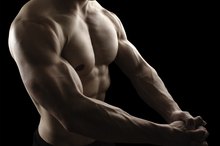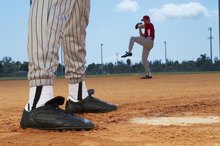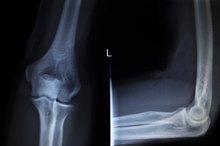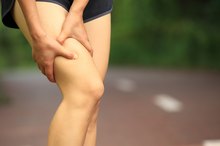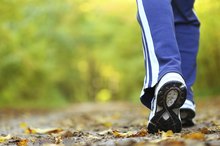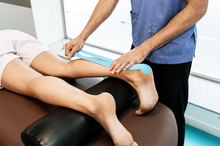How Do the Quadriceps Work & Benefit the Human Body?
You may long for quads that "pop," but there's a lot more to these muscles than aesthetic, shapely legs. Four muscles on the front of the thigh make up the quadriceps. The vastus medialis, lateralis and intermedius attach to the thighbones and shin bones, and the rectus femoris starts at the pelvis and lies across the hip joint. The muscles play a major role in walking and ambulatory movements.
Functions
The quadriceps are involved in almost every movement of your legs. The primary function of the muscles is to bend and straighten your knee. The rectus femoris muscle is also is the primary muscle involved in rotating the hips. Your quads work in concert with other leg muscles, such as the hamstrings, to promote effective movement, running, squatting, cycling and balance.
Read More: The Best Quad Exercises for Runners
- The quadriceps are involved in almost every movement of your legs.
- The primary function of the muscles is to bend and straighten your knee.
Care
Strain of the Pectoral Muscle
Learn More
When the quads are damaged or overused, they can make it difficult to get around. Quads, like all other major muscle groups, require care and maintenance. Stretching is one of the most effective ways to keep the quadriceps flexible, increase their range of motion and maintain appropriate blood and oxygen circulation in them.
Warm up your quads with dynamic stretching -- for example, gentle aerobic exercise such as walking on a treadmill or marching in place -- before you begin working out. For a static stretch after your workout, stand next to a stable object and hold one foot up behind your rear end. Gently pull your foot toward your body and feel the stretch in your quad. Hold for 20 seconds, release and repeat on the other leg.
- When the quads are damaged or overused, they can make it difficult to get around.
- For a static stretch after your workout, stand next to a stable object and hold one foot up behind your rear end.
Possible Injury
Any one of the four muscles can be damaged, resulting in a small tear or total rupture. The muscles are particularly vulnerable to strain and tears when you perform strenuous activities without warming up the muscles first.
The rectus femoris is the most commonly injured muscle and often is injured while kicking, sprinting or jumping. You'll know when you've damaged one of the quadriceps muscles when you feel a twinge or spasm in your thigh or when walking becomes uncomfortable. A more serious tear results in swelling and severe and sudden pain.
Read More: Quadriceps Exercises Using Your Body Weight
- Any one of the four muscles can be damaged, resulting in a small tear or total rupture.
- The muscles are particularly vulnerable to strain and tears when you perform strenuous activities without warming up the muscles first.
Treatment
Symptoms of a Torn Pectoral Muscle
Learn More
Depending on the severity of the damage, you may be out of commission to participate in sports and strenuous exercise for up to 12 weeks. Without effective quadriceps, you cannot compete in competitive events, training and may even require surgery.
Sports massage can help relieve the discomfort of mildly strained quads, and either electrical stimulation or ultrasound can speed healing. For mild tears, you may be able to use your quads soon after following a period of rest, ice, compression and elevation, or RICE. Compression bandages may allow you to maintain mobility while the injury heals.
- Depending on the severity of the damage, you may be out of commission to participate in sports and strenuous exercise for up to 12 weeks.
- For mild tears, you may be able to use your quads soon after following a period of rest, ice, compression and elevation, or RICE.
Related Articles
References
- International Journal of Sports Physical Therapy: Current Concepts in Muscle Stretching for Exercise and Rehabilitation
- Sports Injury Clinic: Quadriceps Strain
- Brittanica: Quadriceps
- Chandler TJ, Brown LE. Conditioning for Strength and Human Performance, Third Edition. Routledge; 2018.
- Kaeding CC, Borchers JR. Hamstring and Quadriceps Injuries in Athletes, A Clinical Guide. Springer; 2014.
- University of Washington Department of Radiology. Rectus femoris. 2020
- University of Washington Department of Radiology. Vastus lateralis. 2020
- University of Washington Department of Radiology. Vastus medialis. 2020
- University of Washington Department of Radiology. Vastus intermedius. 2020
- Kopydlowski N.J., Weber A.E., Sekiya J.K. "Functional Anatomy of the Hamstrings and Quadriceps." In: Kaeding C., Borchers J. (eds) Hamstring and Quadriceps Injuries in Athletes. Boston, MA: Springer; 2014:1–14.
- Miao P, Xu Y, Pan C, Liu H, Wang C. Vastus medialis oblique and vastus lateralis activity during a double-leg semisquat with or without hip adduction in patients with patellofemoral pain syndrome. BMC Musculoskelet Disord. 2015;16:289. doi:10.1186/s12891-015-0736-6
- Loyola University Medical Education Network. Vastus medialis.
- Morgan S, Janse van Vuuren EC, Coetzee FF. Causative factors and rehabilitation of patellar tendinopathy: A systematic review. S Afr J Physiother. 2016;72(1):338. doi:10.4102/sajp.v72i1.338
- Bodor M. Quadriceps protects the anterior cruciate ligament. J Orthop Res. 2001;19(4):629-33. doi: 10.1016/S0736-0266(01)00050-X.
Writer Bio
Linda Ray is an award-winning journalist with more than 20 years reporting experience. She's covered business for newspapers and magazines, including the "Greenville News," "Success Magazine" and "American City Business Journals." Ray holds a journalism degree and teaches writing, career development and an FDIC course called "Money Smart."
